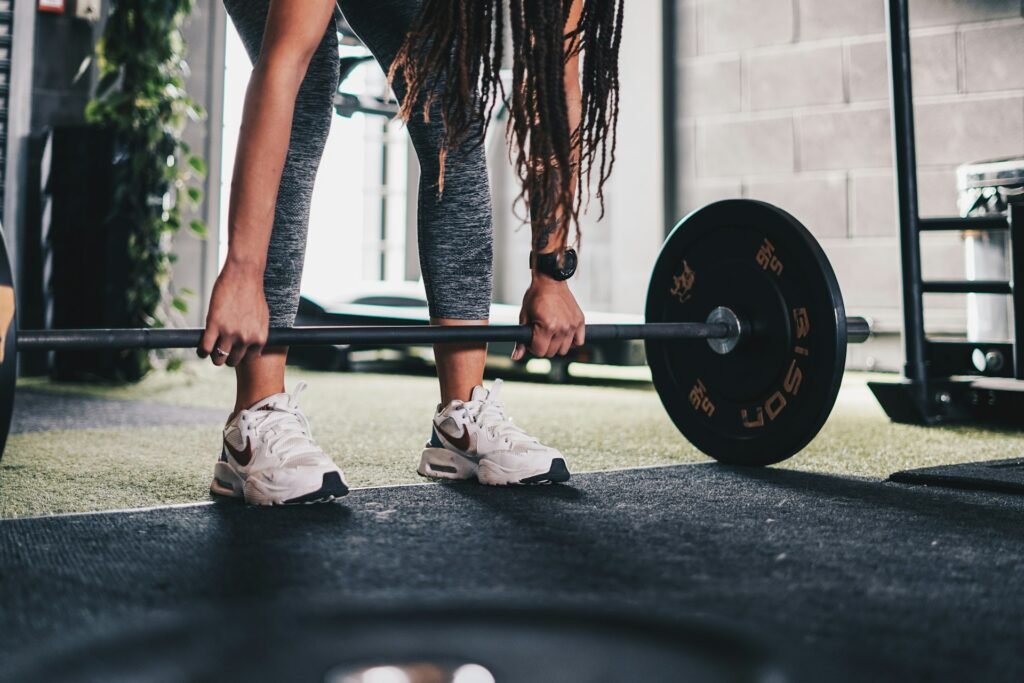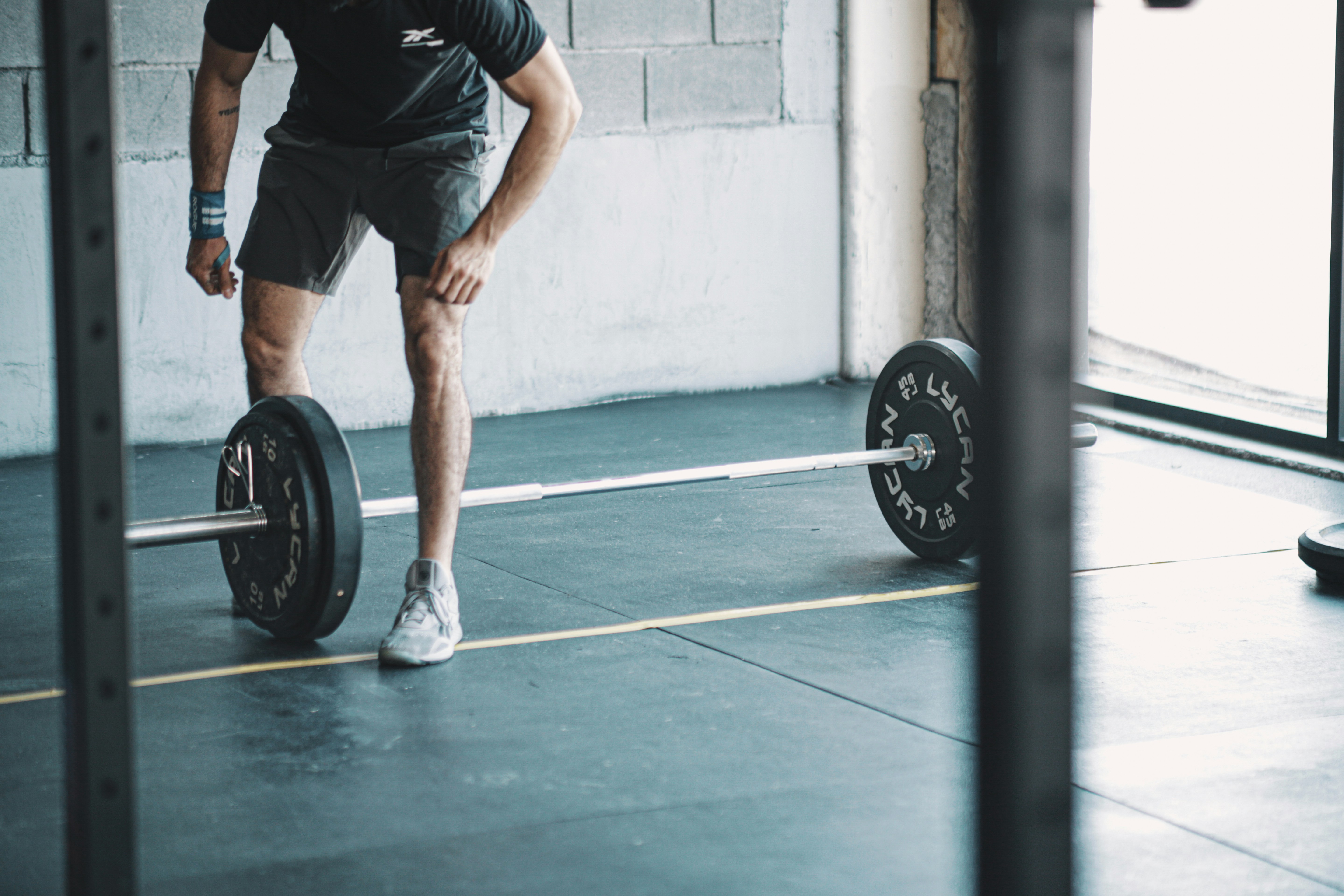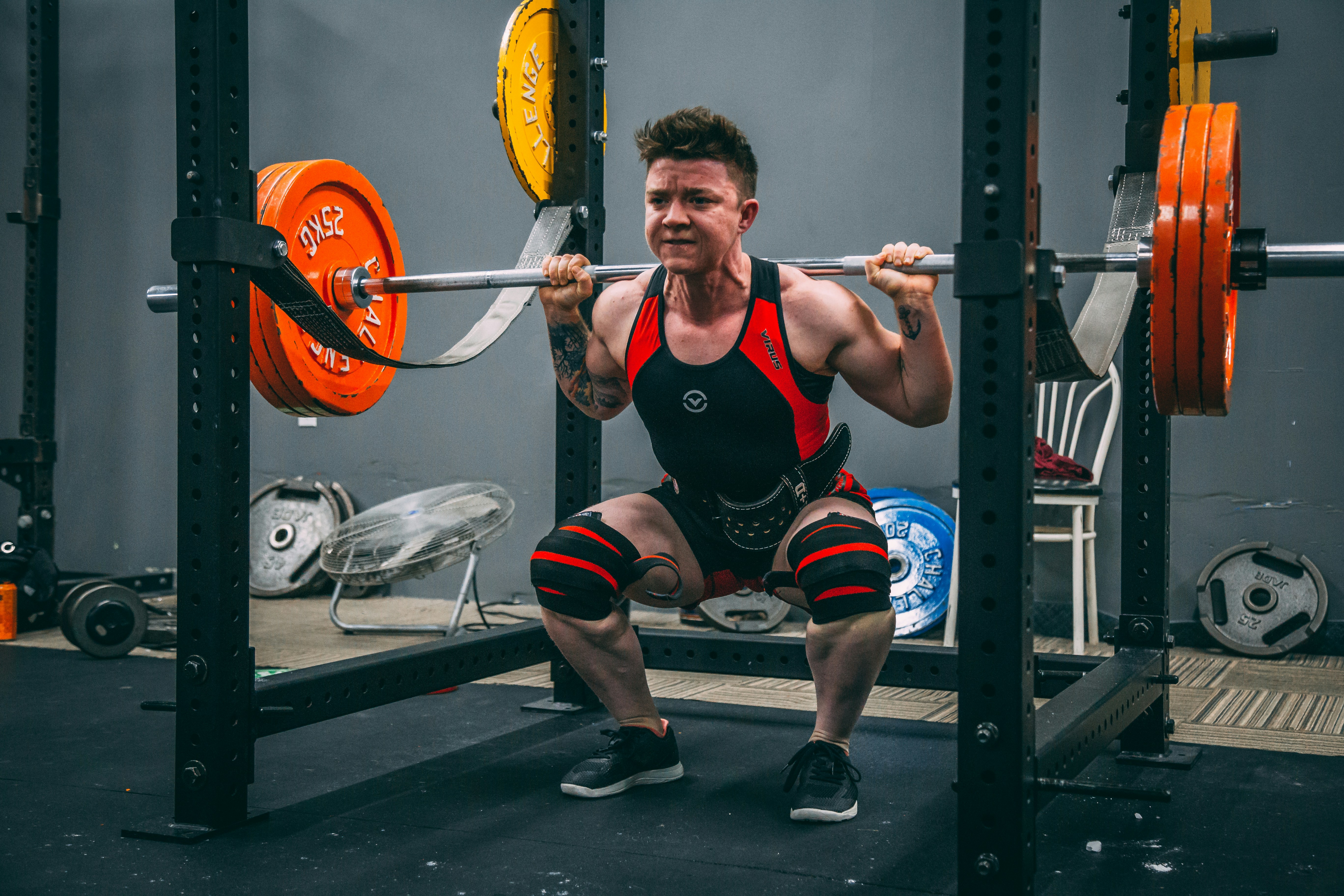
Photo by Ambitious Studio* – Rick Barrett on Unsplash
Full-body barbell workouts offer a well-rounded approach to fitness that targets all major muscle groups in a single session. This efficient method of training ensures you maximize your gym time while reaping a multitude of benefits.
- Effective Use of Time: Compound movements in full-body barbell workouts, like squats and deadlifts, engage multiple muscle groups simultaneously. This increased activity means more calories burned in a shorter amount of time. According to a study published in Frontiers in Physiology, compound exercises lead to greater strength gains compared to single-joint exercises (Paoli et al., 2017).
- Muscle and Strength Gains: Lifting heavy with barbells allows you to hit your muscles harder. Barbell exercises enable you to use heavier weights compared to dumbbells, which is crucial for building muscle mass and strength. When aiming to increase strength, lifting around 80-100% of your one-repetition maximum (1RM) for 1-5 repetitions per set is most effective (Schoenfeld et al., 2021).
- Versatility: Barbells offer a range of exercises that can be modified to fit any fitness level. Whether you’re doing barbell lunges or overhead presses, you can easily adjust the weight to match your strength and skill. This adaptability makes barbell workouts suitable for both beginners and advanced lifters.
- Improved Coordination and Balance: Full-body barbell workouts often mimic natural movements, which improves overall functional fitness. By engaging stabilizer muscles during exercises like the deadlift, you’ll enhance your balance and coordination. This has practical benefits for daily activities and reduces the risk of injury.
For those new to barbell training or seasoned lifters looking to refresh their routine, incorporating full-body barbell workouts can lead to significant improvements in both muscle size and overall fitness. Learn more about specific barbell workouts like the Romanian Deadlift to diversify your training regime and target different muscle groups effectively.
References
The Benefits of Full-Body Barbell Workouts

Photo by Eduardo Cano Photo Co. on Unsplash
Full-body barbell workouts offer a range of advantages for individuals aiming for a balanced and efficient fitness routine. One major benefit is the ability to target multiple muscle groups with a single exercise. For example, barbell squats not only focus on the legs but also engage the core and lower back muscles. This leads to more efficient workout sessions, maximizing results in less time.
Another advantage is the increase in overall strength. Since barbells allow for the use of heavier weights compared to other equipment like dumbbells, they enable lifters to progressively overload their muscles. Progressive overload is essential for muscle growth and strength gains. According to experts, heavier resistance training with barbells can significantly improve muscle mass and strength, making it an effective strategy even for beginners (MasterClass).
In addition to muscle activation and strength gains, full-body barbell workouts can be beneficial for cardiovascular health. Because these exercises often involve compound movements, they can elevate heart rate and improve cardiovascular endurance. Barbell exercises such as deadlifts and cleans, which require full-body coordination, also enhance functional fitness, making everyday tasks easier and safer to perform.
Moreover, barbell workouts are versatile and can be adapted to various fitness levels and goals. Whether you’re looking to build muscle, lose weight, or increase endurance, incorporating barbell exercises into your routine can help you achieve diverse fitness objectives. If you’re interested in exploring more about building muscle and cardio combinations, check out how much cardio should I do a week when trying to build muscle.
Effective Warm-Up Strategies
A well-rounded warm-up is essential to prepare your body for a full-body barbell workout. It helps increase blood flow, improves muscle elasticity, and helps prevent injuries. According to Harvard Health Publishing, an effective warm-up should last between 5 to 10 minutes and should be tailored to the intensity of your workout [^1^].
General Warm-Up Techniques
- Marching in Place: Spend a few minutes marching in place while swinging your arms. This simple activity raises your heart rate and activates your leg muscles, including hip flexors, gluteal muscles, and quadriceps.
- Arm Circles: Extend your arms to your sides and move them in small, medium, and large circles. Do this for 30 seconds in both forward and backward directions. Arm circles help loosen up the shoulder muscles and the rotator cuff.
Specific Warm-Up Techniques for Barbell Workouts
For more intense workouts, such as those involving barbell exercises, you need a more focused warm-up:
- Step-Ups: Face a staircase and take one step up, then step back down. Repeat 10 times for each leg. Step-ups engage your quadriceps and gluteal muscles.
- Torso Rotations: Stand with your feet shoulder-width apart and rotate your torso left and right. This helps prepare your core and lower back muscles for the workout.
- Air Punches: Stand in place and punch the air in front of you. Alternate punches from right to left for 30 seconds. This not only increases your heart rate but also activates the muscles in your arms and shoulders.
Post-Warm-Up Stretches
After completing your workout, finish with some stretching exercises. Hold each stretch for 30 to 60 seconds, focusing on major muscle groups like the shoulders, gluteal muscles, hamstrings, quadriceps, and calves to keep them flexible and ready for the next session.
For more detailed information on similar exercises and their benefits, check out our Back Exercises with Barbell page.
[^1^]: Harvard Health Publishing
Core Barbell Exercises Explained
Barbell exercises are a powerful way to enhance core strength, offering a unique challenge compared to traditional bodyweight workouts. Using a barbell can effectively target muscles like the transverse abdominis, rectus abdominis, and obliques, which play key roles in stabilizing the hips, spine, and overall body during various movements.
- 1. Barbell Sit-Up: This variation increases the intensity of the traditional sit-up. By adding the barbell, your abs work harder to stabilize the weight. To perform, lie on the floor with a barbell held above your chest. Lift your torso towards a seated position, ensuring the barbell stays aligned over your chest. Repeat for a set of 10 repetitions.
- 2. Front Squat: This exercise primarily strengthens the legs but also heavily engages the core. Hold a barbell at chest level, just below the collarbone. Keep your elbows lifted and torso upright as you squat down, then return to the starting position. Aim for 10 reps.
- 3. Landmine Anti-Rotation: This exercise is excellent for improving core stability. Place one end of a barbell in a landmine base and hold the other end at chest level. Without rotating your torso or hips, slowly lower the barbell to the left and right sides. Perform 10 repetitions per side.
- 4. Zercher Squat: Holding a barbell in the crook of your elbows, perform a squat. This position forces your core to stabilize the load more than a traditional back squat. Complete a set of 10 reps.
Core strength is crucial for preventing injuries and enhancing performance. Using a barbell not only increases the difficulty but also engages more muscle groups, making your workouts highly effective.
For more information on improving core workouts, you might find our article on Low Impact Cardio for Bad Knees helpful.
Top Barbell Exercises for a Full-Body Workout

Photo by Alora Griffiths on Unsplash
Back Squat
The back squat is fundamental for targeting the lower body muscles, particularly the quadriceps, hamstrings, and glutes. It’s highly recommended for functional strength. Position the barbell on your upper back, maintain a shoulder-width stance, and squat down until your thighs are parallel to the floor before pushing back up. This movement is crucial for developing lower body strength and stability.
Conventional Deadlift
This exercise is effective for building overall strength and muscle mass. The deadlift targets the hamstrings, glutes, and lower back. Stand with your feet shoulder-width apart, grip the barbell, and lift by straightening your legs and driving your hips forward. Keep the bar close to your body throughout the movement.
Bench Press
The bench press is paramount for upper body development, focusing on the chest, shoulders, and triceps. Lie on a bench, grip the barbell with hands shoulder-width apart, and lower the bar to your chest before pressing it back up. Variations like the incline bench press can target different parts of the chest.
Standing Overhead Press
This exercise emphasizes the shoulders and upper chest. With a shoulder-width grip, lift the barbell from chest height to overhead. Ensure your core is tight and your back is straight to avoid injury.
Barbell Lunges
Barbell lunges are great for single-leg strength and balance. Place the barbell on your upper back, step forward with one leg, and lower your body until both knees are bent at a 90-degree angle. Alternate legs for a comprehensive workout.
Romanian Deadlift
The Romanian deadlift targets the posterior chain, particularly the hamstrings and glutes, and helps improve overall flexibility. With a shoulder-width grip, lower the barbell while keeping your legs slightly bent. Return to the standing position by driving your hips forward.
Barbell Biceps Curl
This exercise is essential for building bicep strength and size. Stand with your feet hip-width apart, grip the barbell with an underhand grip, and curl it toward your shoulders. Slowly lower the barbell back to the starting position.
For more information on how to incorporate these exercises into a structured workout routine, you can visit our full-body barbell workout guide. Additionally, if you’re interested in comparing the benefits of barbell and dumbbell exercises, check out our detailed comparison on dumbbell vs barbell bench press.
By incorporating these core barbell exercises, you ensure a balanced full-body workout that enhances both strength and muscle mass.
Sample Full Body Barbell Workout Routines
When crafting a barbell workout, it’s vital to focus on balance and efficiency. Here are three sample routines: Strength, Hypertrophy, and Power, designed to target multiple muscle groups for varied training benefits.
Strength Routine
For building raw strength, focus on lower rep ranges with heavier weights. This approach engages multiple muscle groups and enhances overall power.
- Barbell Conventional Deadlift
- Rounds: 3
- Reps: 4-6
- Barbell Bench Press
- Rounds: 3
- Reps: 9-12
- Barbell Back Squat
- Rounds: 3
- Reps: 4-6
- Barbell Bent-over Row
- Barbell Bent-over Row
- Rounds: 3
- Reps: 9-12
Finish with:
Standing Barbell Overhead Press: EMOM for 5 minutes, 3 reps each minute.
Hypertrophy Routine
For muscle growth, use moderate weights with higher rep ranges. This maximizes muscle tension and growth.
- Barbell Lunge
- Rounds: 4
- Reps: 8-12 per side
- Barbell Bent-Over Row
- Rounds: 4
- Reps: 8-12
- Romanian Deadlift
- Rounds: 4
- Reps: 8-12
- Standing Barbell Overhead Press
- Rounds: 4
- Reps: 8-12
Perform these exercises as a giant set with no rest between exercises and 60-90 seconds rest between rounds.
Power Routine
To enhance explosive power, use lighter weights with rapid movements. Focus on speed and technique.
- Hang Power Clean
- Rounds: 4
- Reps: 3
- Bench Press
- Rounds: 4
- Reps: 3-5
- Barbell Conventional Deadlift
- Rounds: 3
- Reps: 3-5
- Standing Barbell Overhead Press
- Rounds: 3
- Reps: 3-5
Workouts are designed to perform exercises in supersets for efficiency. For instance, complete 3 rounds of Hang Power Clean followed immediately by Bench Press before moving to the next set.
For those interested in the benefits of various exercise machines and comparing their outcomes, check out this article on treadmill vs. exercise bike for fat loss.
By following these routines, you’ll cover all aspects of fitness — strength, muscle growth, and power — ensuring a well-rounded workout plan.
Expert Advice and Closing Remarks
If you want to transform your fitness regimen, full-body barbell workouts are a fantastic option. According to fitness experts, these routines are highly effective for building strength and burning calories. A balanced full-body workout increases overall muscle mass and enhances endurance.
For optimal results, it’s crucial to use the correct form to avoid injuries. Consulting a certified trainer for personalized guidance can be beneficial. According to a 2020 study, the prevalence of gym-related injuries decreased by 40% in individuals who received professional training (source). Using a professional trainer can also help in tailoring the workouts to match your fitness goals and capabilities.
Ready to try a full-body barbell workout? Start with a light warm-up, followed by foundational exercises like squats, deadlifts, and presses. Incorporate rest days to allow your muscles to recover and grow. If you want to expand your workout routine, consider our article on barbell leg workouts for more detailed guidance.
As you wrap up our guide, remember that consistency is key. Keep challenging your body by progressively increasing the weights and adjusting your workout routine. Quoting Yehuda Berg, “Words are singularly the most powerful force available to humanity,” and the same can be said for disciplined actions in your fitness journey. Maintain dedication, and you’ll see significant results in no time. For more comprehensive tips on fitness, check out our discussions on cardio recovery rate.